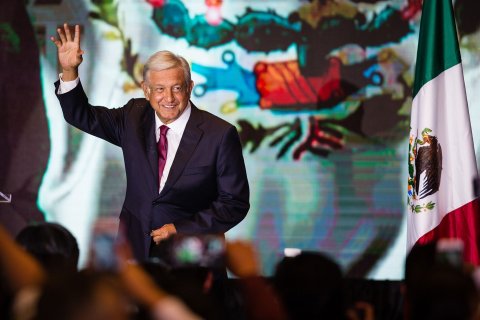When Muslim rioters burned down his shop in northern Nigeria around 2015, Stephen fled the sectarian campaign against Christians like himself and headed south. But soon more violence erupted; government troops clashed with supporters of a secessionist movement in Nigeria's southeast, echoing the tensions that had plunged the country into civil war 50 years earlier. He had not heard from his father or sister since the riots over a year before, and, fearing for his life, he set out last September for Ecuador and, ultimately, the United States—more than 10,000 miles and an ocean away.
Stephen joined thousands of other migrants along the land route from South America, traveling by foot, bus and boat across seven countries to the U.S.-Mexico border, where they had told him he could claim asylum. Fellow Nigerians, however, abandoned him in the dense Colombian jungle. He was lost for days before another group of Africans and an Indian found him. Later, he risked rough coastal waters at night on a crowded smuggler's dinghy, although he couldn't swim, to evade checkpoints in Nicaragua.
Finally, three months after leaving Nigeria, he got off a bus in Tijuana, Mexico. But the migrants and advocates gathered there had bad news: He couldn't go forward. Six months later, as he cooked stew in a church shelter in the sweltering June heat, he was still waiting.
"They said we cannot go to U.S.," Stephen told me, speaking on condition that his last name be withheld to protect against threats to himself in Mexico and to his family back home. "I hear stories they return them to go back. You don't even have nothing to fall back on. It is as if they killed you."
While President Donald Trump has railed against Mexico for doing "nothing" to stop migrants from reaching the U.S. border, saying they travel through the country "like it's walking through Central Park," this is the reality for thousands who come to Mexico from around the world to seek asylum in the United States. Whether a Nigerian Christian, an Angolan political exile or a pregnant Mexican mother carrying her 2-year-old more than 1,500 miles north, asylum seekers tell Newsweek they are trapped in limbo by the Trump administration's ever-shifting immigration policy, with officials now widely employing a controversial deterrence tactic: making migrants wait in Mexico, indefinitely.

Every day in Tijuana, a growing stream of migrants line up outside the San Ysidro Port of Entry to claim asylum; the mass of concrete, known here as "El Chaparral," is one of the busiest land-border crossings in the world. Yet in a pattern that's being repeated at such entrances in California, Arizona and Texas, Mexican authorities and volunteers—at the behest of U.S. immigration officials—are doling out numbers to migrants that take weeks to be called, or never get called at all.
Asylum seekers tell Newsweek that often they're told by U.S. officials that authorities are "at capacity." Sometimes, they're physically turned back by an armed U.S. Customs and Border Protection (CBP) agent. Faced with the arbitrary and chaotic enforcement of Trump's "zero tolerance" policy and his broader immigration crackdown, some have all but given up on requesting asylum in the United States. Advocates, lawyers and immigration experts say it's all part of a deliberate strategy by the Trump administration to skirt U.S. and international legal obligations that require border authorities to accept and protect asylum seekers.
Adam Isacson of the Washington Office on Latin America, a human rights nonprofit, recently returned from observing the port entry in Nogales, Arizona. There, he says, CBP is processing only about six asylum seekers a day—despite a holding capacity of 47, long lines of people waiting outside and empty chairs inside. "They're keeping the ports of entry as sluggish as possible," he says. "The net impact of which is no people from the Third World coming to the United States and asking for asylum, or keeping it to the thinnest trickle."
A CBP spokesperson rejected the allegations, saying, "CBP is not denying or discouraging travelers from seeking asylum or any other form of protection." CBP did, however, acknowledge that it was "temporarily limiting entry" at San Ysidro because the port's "operational capacities" have been met and the agency facilities were not designed to process or hold "hundreds of asylum seekers at one time." CBP has previously said San Ysidro has the detention capacity for up to 300 people.
Either way, the administration's approach effectively forces a "safe third country" arrangement on Mexico, making it an international waiting room. Mexico has begun extending "transit visas," intended to temporarily grant migrants permission to pass through, for indeterminate stays. The country's embassy to the United States said in a statement that an enforcement-only policy, without economic development—which broadly characterizes the Trump administration's attitude toward the region—won't resolve migration issues.
For global asylum seekers at the border, the situation appears to be a permanent purgatory, as they are unable to go forward or back. While the vast majority are Central American, they are also coming from as far away as sub-Saharan Africa and South Asia. From January to June, Mexican authorities have recorded 2,317 Asian and 775 African migrants. In May, U.S. Citizenship and Immigration Services Director L. Francis Cissna told lawmakers that asylum applications had tripled to 142,000 between 2014 and 2017, and that the backlog had grown to 318,000 cases. While about 80 percent of asylum seekers pass their initial screening, known as the "credible fear" interview, only roughly one-fifth of applicants were granted asylum in fiscal year 2017.
Trump officials have vowed to end what they allege is widespread abuse of the asylum system, part of a larger effort by the administration to restrict legal—as well as illegal—immigration. In October, Attorney General Jeff Sessions said "dirty immigration lawyers" give clients "magic words" to "make false claims of asylum" (though many asylum seekers don't have representation). The Trump administration has railed against having to consider the "credible fear" of those who claim asylum after entering the country between ports of entry.
But officials have also heightened scrutiny of "affirmative" asylum claims, typically those made after legal entry; in Trump's first year, officials approved such requests at a 20 percent lower rate, on average, than in the Obama administration's last year. In June, the Justice Department issued guidance that said gang and domestic violence should no longer qualify as grounds for asylum.
Legal experts question the Trump administration's recent actions. Illegal immigration, they note, is at historic lows. Twenty years ago, Border Patrol apprehensions reached more than 1.5 million. In fiscal 2017, when Trump took office, they dropped to 304,000, the lowest number in nearly half a century. This year, apprehensions rose for a few months before dropping off 15 percent from May to June. (Administration officials attribute the decrease to the zero tolerance policy, but it also tracks with annual seasonal trends.) And June's 34,057 arrests, immigration advocates note, pale in comparison to June 2014, when a spike in unaccompanied minors from Central America led the Obama administration to increase resources at the border to avoid bottlenecks.
To be sure, past administrations have struggled to process asylum seekers. In 2016, when thousands of Haitians came to San Ysidro, CBP and its Mexican counterparts limited the numbers accepted each day, and in Texas, authorities built temporary tents for migrants being processed. But the range of practices being employed now to deter or delay them is new, experts contend, as is the extent of the backlogs at the border.
Advocates say Trump has made his motivations clear, questioning in meetings why the U.S. should take immigrants from "shithole" countries in Africa, Haitians who "all have AIDS" or Nigerians who would never "go back to their huts," rather than "more people from places like Norway." In June, he said from the White House, "The United States will not be a migrant camp, and it will not be a refugee-holding facility. It won't be."
Immigration lawyers, advocates and former Department of Homeland Security officials say the administration may now be breaking the law. Migrants with a "well-grounded" fear of persecution back home, based on their race, religion, nationality, political beliefs or membership in a particular social group, can apply for asylum, but not from outside the U.S.; they must be either at the border or already inside the country. That's why enacting "roadblocks" for asylum seekers is unlawful, says Lee Gelernt, deputy director of the American Civil Liberties Union's Immigrants' Rights Project.
According to Lindsay Harris of the American Immigration Lawyers Association, by telling asylum seekers at ports of entry there's "no vacancy," U.S. officials are violating the 1951 Refugee Convention, which the country signed on to, as well as the U.S. Refugee Act of 1980. U.S. authorities cannot threaten asylum seekers, tell them they can't apply, treat one group differently from another or return them to a place—or keep them in one—where they fear a threat to their life, unless they have been convicted of a serious crime or officials "reasonably" determine they threaten national security. Mexican authorities have told Harris's clients, who come from such places as Honduras, Cameroon and Uganda, that they should not claim asylum in Mexico because officials cannot protect them from cartels or official corruption.
Now, according to drafted regulations reported by Vox, the Trump administration wants to render ineligible for asylum anyone who spent more than two weeks in another country or who traveled through more than one country on the way to the United States without applying for asylum. Also banned would be those who cannot articulate the legal basis for their claim. The measures being considered could "wipe out" practically all genuine asylum claims, says Stephen Legomsky, senior counsel to the Department of Homeland Security under President Barack Obama.
The proposal puts the U.S. on a crash course with Mexico, which is struggling with its own immigration crisis. The number of people seeking asylum in Mexico has also skyrocketed, increasing by more than 1,000 percent between 2013 and 2017. In recent years, the country has detained and deported more Central Americans than the U.S. has. So far this year, nearly 55,000 foreigners presented themselves to migration authorities in Mexico, according to the Mexican government. Authorities returned more than 80 percent of them.'

Newly elected Mexican President Andrés Manuel López Obrador, also known as AMLO, has pledged to push back on Trump's immigration crackdown. After his victory, he said bilateral relations included defending "our migrant countrymen" in the United States. His public security adviser has specified that "military and police force will not be used to repress the [migrant] population" traveling through Mexico. Meanwhile, in Tijuana, the migrants wait.
A few weeks before AMLO's election, Tania Peña, 21, fled Michoacán on Mexico's Pacific coast, five months pregnant and carrying her 2-year-old son. She escaped a husband who she said was involved with the "narcos" and had threatened to take their children. She had waited a week at the U.S. border, sleeping at night at a shelter for women and kids and listening each day at El Chaparral for No. 239.
At a men's shelter next door, Nikoleka Kipioka and his friend Armando each say they'd been arrested in Angola during protests against the government and left immediately after they'd been let out of prison. They'd met on their journey from Africa to Mexico, where they'd waited at the border for about three weeks. They shared No. 258. It was never called. "To enter, you must wait for your number for many days, then after that, you are told the list is lost," Kipioka says. "Now, I have another number: 404."
In a church kitchen across the city, Stephen, the Nigerian Christian, ate his stew. He's not ready to risk rejection at the border; he's heard rumors from fellow migrants that African asylum seekers are being deported. So he works at car washes around Tijuana, tries to improve his Spanish and waits.
"I would still love to go to United States," he says. "It's the only hope you have to live as a human being."
Gabriela M. Cordova contributed reporting.












